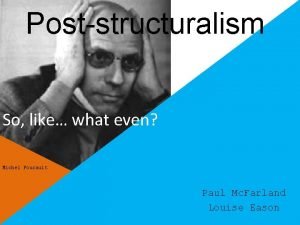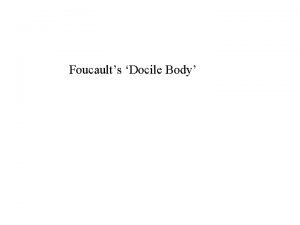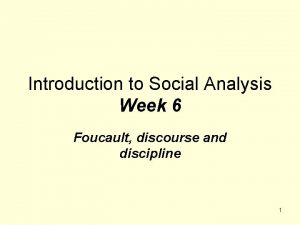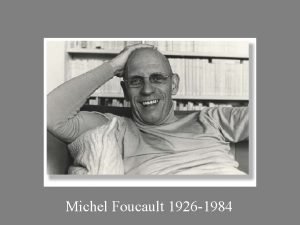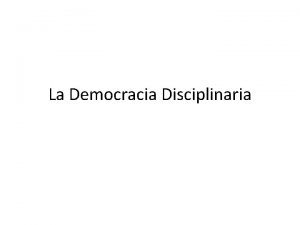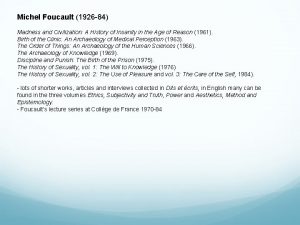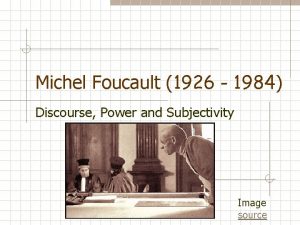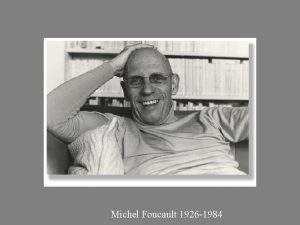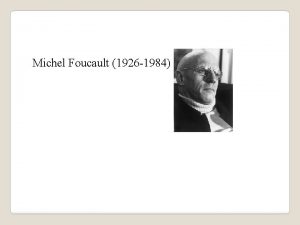Michel Foucault 1926 1984 Madness and Civilization A

![“The Narrenschiff […] is a literary composition, probably borrowed from the old Agronaut cycle[…] “The Narrenschiff […] is a literary composition, probably borrowed from the old Agronaut cycle[…]](https://slidetodoc.com/presentation_image_h2/df93269143497829f98295777a03077a/image-2.jpg)









- Slides: 11

Michel Foucault (1926 -1984) Madness and Civilization A French philosopher, historian, intellectual, critic and sociologist. He held a chair at the College de France with the title ‘History of Systems of Thought”, and also taught at the University of California, Berkley. His work on power and the relationship between power, knowledge and discourse has been largely discussed. In 1960 s Foucault was often associated with the structuralist movement. Though sometimes characterised as poststructuralist and post-modernist, Foucault rejected those labels. Died of an AIDS-related illness in 1984 and was the first highprofile French personality who was reported to have AIDS. Leper vagabonds and “deranged minds” Diseased body folly/madness deseased mind
![The Narrenschiff is a literary composition probably borrowed from the old Agronaut cycle “The Narrenschiff […] is a literary composition, probably borrowed from the old Agronaut cycle[…]](https://slidetodoc.com/presentation_image_h2/df93269143497829f98295777a03077a/image-2.jpg)
“The Narrenschiff […] is a literary composition, probably borrowed from the old Agronaut cycle[…] acquiring an institutional aspect in the Burgundy Estates. […] these boats conveyed their insane cargo from town to town. ” (8) Apocalypse madness Death “…the mockery of madness replaces death and its solemnity. ” (15)

“No doubt, madness has something to do with the strange paths of knowledge. The first canto of Brand’s poem is devoted to books and scholars…Erasmus […] reserves a large place for scholars… But if the knowledge is so important to madness, it is not because the latter can control the secrets of knowledge; on the contrary, madness is the punishment of a disorderly and useless science. If madness is the truth of knowledge, it is because knowledge is absurd, and instead of addressing itself in the great book of experience, loses its way in the dust of books and in idle debate; learning becomes madness through the very excess of false learning. ” (25)

“Another symbol of knowledge, the tree, once planted in the heart of the earthly paradise, has been uprooted and now forms the mast of the Ship of Fools… it is this tree, without a doubt, that sways over Bosch’s [painting]. ” (22)

Madness in Renaissance Not a vice, but a human weakness. New forms of madness develop: 1. Madness by romantic identification (Cervantes and his Don Quixote); 2. Madness of vain presumption (present in all men to an extent); 3. Madness of just punishment; 4. Madness of desperate passion (Ophelia and King Lear)

“Scarcely a century later after the career of the mad ships, we note the appearance of theme of the “Hospital of Madmen”, the “Madhouse” […] Retained and maintained. No longer a ship but a hospital…” (35) Reason vs. Unreason “…only by controlling the abnormal can the “normal” exist. ” (38) “Madness was thus torn from that imaginary freedom which still allowed it to flourish on the Renaissance horizon… in King Lear, in Don Quixote. But in a less than a half-century it had been sequestered and, in the fortress of confinement, bound to Reason, to the rules of morality and to their monotonous rights. ” (64)

Madness and art “Where there is no work of art there is no madness… This is the new triumph of madness… The world that tried to justify itself and measure madness through psychology must justify itself before madness. The world measures itself by the works of Nietzsche, Van Gogh and Artaud. But nothing assures the world that it is justified by madness, not even psychology. ” (288 -289)

Important themes in Madness and Civilization 1. Relationship between madness and unreason Unreason is “reason dazzled” or confused during the period of confinement. In the modern period, however, unreason is pushed further beneath the surface of society, and is understandable only through certain artists; madness on the other hand, becomes mental illness, and is treated and controlled by medical and psychiatric practices. Unreason is somehow lost after the eighteenth century.

2. Construction of madness. Foucault insists that madness is not a natural, unchanging thing, but rather depends on the society in which it exists. Various cultural, intellectual and economic structures determine how madness is known and experienced within a given society. In this way, society constructs its own experience of madness. Ultimately, Foucault sees madness as being located in a certain cultural "space" within society; the shape of this space, and its effects on the madman, depend on society itself.

3. Madness and art His central argumet rests on the idea that modern medicine and psychiatry fail to listen to the voice of the mad, or to unreason; they don’t offers a chance of understanding unreason. To do this, we need to look to the work of "mad" authors such as Nietzsche, Nerval and Artaud. Unreason exists below the surface of modern society, only occasionally breaking through in such works. Madness is linked to creativity, but yet destroys the work of art. The work of art can reveal the presence of unreason, but yet unreason is the end of the work of art.

